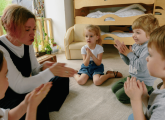Charlotte Hacking shares the importance of picture books for developing visual literacy and skills in early reading, talk and writing...
As a class teacher, school leader and lover of children’s literature, I’ve always been aware of the transformative nature of picture books on children of all ages.
In too many instances, these are seen by adults as a step up into reading novels. However, they are a sophisticated genre of literature in their own right.
Far from being the easy option, picture books challenge readers in more and different ways than print alone.
Reading pictures is just as complex, perhaps more complex, than reading print. In the best picture books, there is space between the pictures and the text. The pictures don’t just simply illustrate the words.
This takes the child reader into very special place. They have to read the text, read the illustrations and then put the ideas together along with their personal experience, knowledge and understanding of the world to fill the gaps in between.
It’s a really challenging thing to do. It enables even the youngest children to develop a wealth of comprehension knowledge and visual literacy skills.
Giving time and space to discussing picture books and responding to illustrations contained within them allows children to gain so much more from the text, and to do more of the weight of the reading work.
Through discussions around picture book spreads in a group, children can:
Joe Todd-Stanton’s A Mouse Called Julian is a great book to use in nursery to develop visual literacy skills. Children are able to recognise the facial expressions and body language of the main character, Julian, from the first endpapers. This is before a word of the story had been shared.
How might he be feeling? What might make him feel this way?
As the story progresses, the illustrations are open enough for the children to be able to take control of conversations around the narrative.
They will offer and develop ideas, making connections between parts of the story and inferring why things have happened or might be about to happen.
The rich, satisfying storyline, the sophistication in the illustrations and the potential for rich discussion with an enabling adult or group of peers are what will:
We must ensure that while children are learning to decode, they are also exposed to rich texts like these that support visual literacy and comprehension and develop their motivation to read.
Young children can also use what they have learnt from picture books to create narratives of their own. Being able to represent thoughts, create characters and tell stories through drawing comes naturally to children in the early years.
It’s the first route to communicating meaning. This is before they are introduced to the symbolic system of print and the letter/sound relationships that allow them to communicate in text.
Allowing opportunities for children to draw regularly and communicate their ideas in pictures allows them to gain key knowledge and skills that form the building blocks of writing.
Take an idea, share it meaningfully, structure and develop your thinking and create authentic characters, settings or ideas for story events.
Copying illustrations helps children develop not only their artistic skills and abilities but also their fine motor skills, paving the way for handwriting.
Author/illustrator draw-along videos show children how to create and shape characters through illustration. This will give them ideas to create characters of their own.
As one Reception teacher commented, “The modelled drawing activity completely shattered my preconceptions of what five-year-olds might be capable of drawing…”
For the very youngest children, teachers involved in our Power of Pictures programme have noticed higher levels of engagement, language development, comprehension and imagination when working with picture books and when being allowed to communicate and develop ideas through drawing.
Shh! We Have a Plan by Chris Haughton
The book has a simple repetitive text which children will quickly access for themselves as they enjoy the pictures. These include Chris Haughton’s characteristic and comical angular and wide-eyed figures.
There is plenty to discuss in regard to the actions of humans on the environment. This links well to a focus on self-regulation in the early years.
Is There a Dog in this Book? by Viviane Schwarz
An inventive, interactive book in which three playful cats directly address the readers, imploring them to keep turning the pages to first hide from and then find a ‘doggy friend’.
The story offers opportunities for children to talk about fears in the context of a known story. They’ll look at how to build and form friendships, taking the needs of others into account. All essential skills to develop in the early years.
The Story Machine by Tom McLaughlin
This book tells the story of Elliot, who one day finds a mysterious machine. He makes it work by accident and discovers that it is a story machine with letters that make words.
However, Elliott finds letters hard to contend with. That is until, with the aid of his imagination and a magnifying glass, he notices a picture amongst them.
This sets him off on the path to a world of his own story-making. A wonderful stimulus for children to make their own stories using pictures and to develop empathy with a character who finds elements of learning difficult.
Charlotte Hacking is the Learning and Programme Director at the Centre for Literacy in Primary Education (CLPE). Find out more about the Power of Pictures programme.

Rhythmic play – Why every setting should do it
Editors picks
